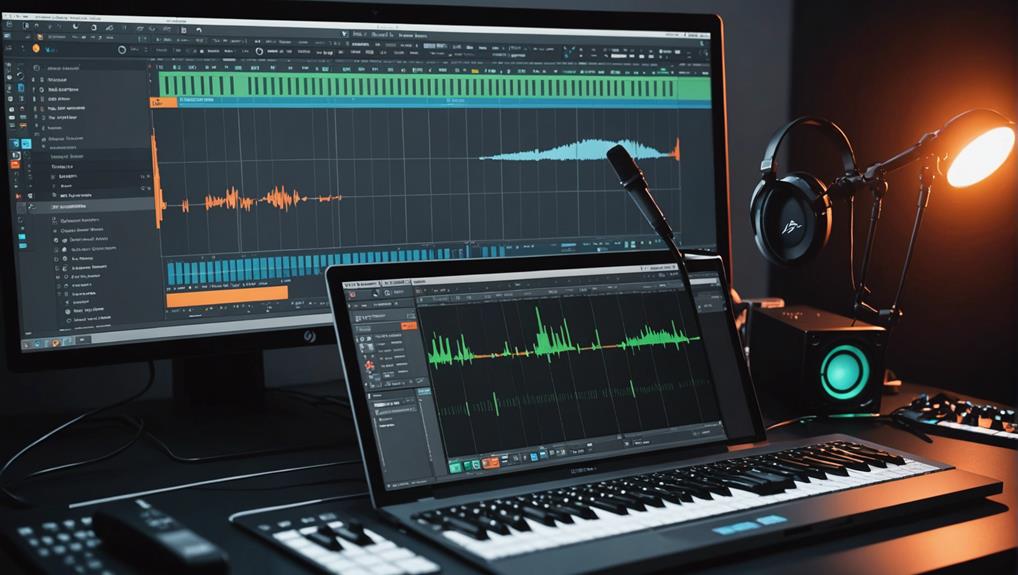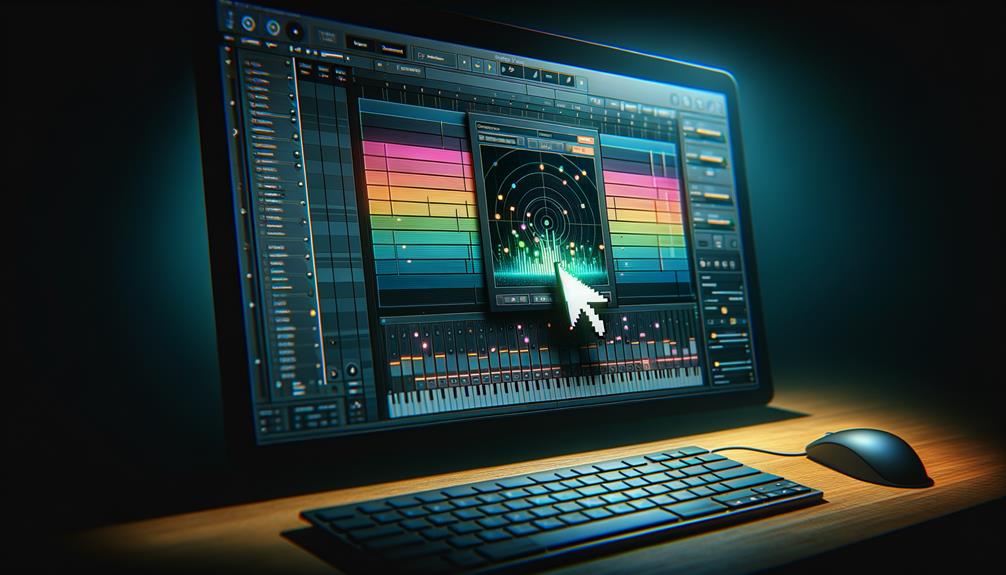To master making beats on FL Studio, follow these seven essential steps. Begin by familiarizing yourself with the interface, focusing on the browser and channel rack for effective sound management. Organize your sounds meticulously for easy access. Next, create dynamic drum patterns with variations in velocity and layering techniques. Adjust the tempo to match your desired style, then mix your tracks using the mixer for balanced sound quality. Use the playlist for proper arrangement, incorporating automation for rich dynamics. Finally, engage with learning resources and the community to refine your skills. More insights await to enhance your production journey.
Key Takeaways
- Familiarize yourself with the FL Studio interface, including the Browser, Channel Rack, and Mixer for efficient workflow.
- Organize your sounds within the Browser and Channel Rack for easy access and enhanced creativity.
- Develop strong drum patterns by experimenting with kick, snare, and hi-hat placements to create dynamic rhythms.
- Utilize the Mixer for volume adjustment, panning, and effects application to achieve a balanced and polished mix.
- Engage with learning resources and online communities for continuous improvement and feedback on your beat-making skills.
Familiarize With the Interface
Steering through the intricate terrain of FL Studio’s interface is akin to mastering a musical instrument; understanding its components is fundamental for effective beat-making.
Begin your journey by exploring the Browser, a significant tool for sound selection and organization. Here, you can categorize sounds like drums and instruments, and even enhance your library by dragging in custom folders.
The Channel Rack is equally important, serving as the hub for managing your selected sounds. It allows for easy arrangement and manipulation of audio elements, forming the backbone of your beat.
Don’t forget to adjust the BPM for the desired tempo, customizing it from the default 140 to suit various musical styles. Understanding the Session View can also enhance your ability to experiment with different arrangements and clip launching techniques.
Familiarizing yourself with these components will enhance your creative workflow.
Organize Your Sounds
Organizing your sounds in FL Studio is essential for a streamlined production process.
By effectively utilizing the Browser, you can quickly access categorized sounds and manage your custom collections with ease.
Additionally, maintaining an orderly Channel Rack guarantees that your samples are readily available for creative exploration and efficient playback. Regularly updating your library with new releases keeps your sound fresh and engaging for your productions.
Utilize the Browser Effectively
An efficient workflow in beat-making often hinges on how well you utilize the Browser in FL Studio.
This essential tool allows for streamlined access to your sounds, particularly when organizing your libraries of drums and presets.
To maximize your productivity, consider the following strategies:
- Categorize Your Sounds: Organize sounds into specific folders for quick navigation, such as separating drums and instruments.
- Drag Custom Folders: Enhance your sound library by incorporating personal collections directly into the Browser for rapid access.
- Regular Maintenance: Regularly update your sound organization to guarantee you can swiftly locate desired sounds during production.
Manage Channel Rack Sounds
While creating a beat in FL Studio, effectively managing sounds within the Channel Rack is essential for a polished final product.
The Channel Rack serves as the heart of your composition, allowing you to organize various instruments and samples efficiently. Each sound corresponds to a unique pattern in the Piano Roll, facilitating precise arrangement and editing.
To guarantee a seamless playback experience, maintain consistent pattern lengths across the Channel Rack. Additionally, enhancing the dynamics of your beat can be achieved by adjusting the volume and velocity of individual notes.
By thoughtfully managing your sounds, you create a cohesive structure that boosts your music production, fostering a more engaging listening experience.
Embrace these strategies to master your craft.
Organize Custom Sound Collections
A well-organized sound collection can greatly enhance your workflow in FL Studio, allowing for streamlined access to essential samples and instruments.
To effectively organize your sounds, consider the following steps:
- Utilize the Browser: Use the Browser in FL Studio as your main hub, categorizing sounds into folders like drums and instruments for easy navigation.
- Add Custom Sounds: Simply drag your custom sound folders into the Browser to make them readily available for your projects.
- Maintain Organization: Regularly review your library, removing unused sounds and updating categories to keep your collection manageable.
Create Drum Patterns
Creating compelling drum patterns is essential for laying down a strong foundation in your beats.
Begin by strategically placing kicks and snares to establish the pulse, then enhance your rhythm with innovative hi-hat variations that add texture and momentum. Additionally, consider using surgical EQ cuts to enhance the clarity of your drum sounds, allowing each element to shine through in the mix.
Kick and Snare Placement
To establish a solid foundation in your drum patterns, effective kick and snare placement is essential. The kick drum and snare drum are the backbone of any rhythm, and their strategic positioning can enhance your beats.
Consider these key placements:
- Kick Drum: Place it on the first beat of each measure to create a strong foundation.
- Snare Drum: Position it on the second and fourth beats for a steady backbeat that propels the rhythm.
- Dynamic Velocity: Adjust the velocity of both the kick and snare to introduce variations, simulating a more human feel.
Hi-Hat Variations and Patterns
Building upon the solid foundation established by effective kick and snare placement, hi-hat variations play a pivotal role in shaping the overall texture of your drum patterns.
Placing hi-hat sounds on every offbeat fosters a consistent rhythmic backbone, commonly utilized across various genres. To enhance dynamic interest and avoid robotic feel, experiment with varying the velocity of individual notes.
Explore different patterns, such as 16th or 32nd notes, to create intricate sequences that captivate listeners. Additionally, incorporating open hi-hats on the upbeat or at the end of a bar injects energy into your beats.
Finally, layering multiple hi-hat sounds, through different pitches or effects, boosts the complexity and richness of your drum patterns, resulting in a more engaging production.
Adjust Tempo and Beats
Adjusting the tempo in FL Studio is a fundamental skill that can greatly influence the character of your music. The default BPM is set to 140, but altering this can open new creative avenues.
Here are three essential tips to effectively adjust tempo and beats:
- Explore BPM Variations: Experiment with tempos, from the recommended 77 BPM for slower beats to higher ranges for energetic tracks.
- Ensure Pattern Consistency: Make sure all patterns in the Piano Roll have the same length to avoid playback issues.
- Match Complexity to Tempo: Slower tempos benefit from intricate patterns, while faster tempos thrive on punchy, straightforward beats. Additionally, understanding mixing techniques can enhance the overall sound quality of your beats, making them more polished.
Mix Your Tracks
Mastering the art of mixing tracks in FL Studio is vital for achieving a polished and professional sound. Utilize the Mixer to manage volume, panning, and effects for each sound linked from the Channel Rack. Balancing levels guarantees clarity, while the EQ allows you to carve out space in the frequency spectrum for each element. Subtractive EQ enhances clarity by cutting unwanted frequencies, so be sure to experiment with built-in presets to enhance quality, and don’t forget to regularly solo tracks to fine-tune your mix.
| Step | Action | Purpose |
|---|---|---|
| 1 | Adjust Volume | Control track presence |
| 2 | Add Effects | Enhance sound quality |
| 3 | Balance Levels | Create a cohesive mix |
| 4 | Use EQ | Prevent frequency clashes |
| 5 | Solo Tracks | Identify needed adjustments |
Arrange in the Playlist
A well-organized Playlist in FL Studio is essential for crafting intricate and compelling beats. This workspace allows you to compile and arrange sounds from the Channel Rack, creating a structured composition that showcases your creativity.
To maximize your efficiency, consider the following steps:
- Organize Tracks: Allocate separate tracks for various elements, such as drums, melodies, and effects, to maintain clarity in your arrangement.
- Adjust Lengths: Modify the length and position of sound blocks to create smooth shifts and dynamic build-ups throughout your beat.
- Utilize Automation: Enhance your tracks with automation clips, allowing gradual changes in volume, panning, or effects over time for a polished final product. Additionally, mastering your arrangement in the Playlist can significantly improve music production quality, as it allows you to experiment with different sound combinations and transitions effectively.
Explore Learning Resources
While starting on your journey to master beat-making in FL Studio, tapping into a variety of learning resources can greatly enhance your skills and understanding of the software.
In-depth video tutorials that focus on the Piano Roll and Mixer provide targeted education, fostering essential beat-making techniques. A thorough FL Studio playlist covers sound selection and pattern building, allowing you to grasp fundamental production methods effectively.
For those seeking advanced strategies, a master class offers invaluable insights, with feedback highlighting significant improvements over free resources.
By engaging with regular updates and new content shared weekly, you can continuously refine your skills. Additionally, understanding the importance of proper setup and configuration will significantly impact your recording quality and overall performance.
Community involvement, through likes and subscriptions, shapes future tutorials, creating a collaborative environment for all Music enthusiasts.
Frequently Asked Questions
How to Start Producing Beats in FL Studio?
To initiate beat making in FL Studio, begin with meticulous sound selection. Create a blank project, explore categorized sounds, adjust tempo, and utilize the Piano Roll for crafting intricate melodies, ultimately organizing your patterns within the Playlist.
Can You Master With FL Studio?
Yes, FL Studio enables effective mastering through its advanced mixing techniques and a variety of audio effects. Users can manipulate dynamics, apply EQ, and utilize third-party plugins to achieve a professional-quality final mix.
How Do I Master My Beat?
To master your beat, focus on meticulous beat mixing by adjusting levels, panning, and incorporating audio effects like EQ and reverb. This collaborative approach enhances clarity and depth, ensuring a polished, professional sound throughout your track.
How to Master a Beat on FL Studio 20?
To master a beat in FL Studio 20, focus on meticulous sound selection and effective beat layering. Employ the Mixer for balance, and experiment with effects while seeking collaborative feedback to refine your track’s overall impact.
Conclusion
Mastering beat-making in FL Studio entails a systematic approach that enhances creativity and technical proficiency. By familiarizing with the interface, organizing sounds, constructing drum patterns, and adjusting tempo, musicians can effectively build a foundation. Additionally, mixing tracks and arranging them in the playlist further refines the overall sound. Exploring various learning resources fosters ongoing development and collaboration within the music community. Ultimately, these steps collectively contribute to achieving a high level of mastery in beat production.



